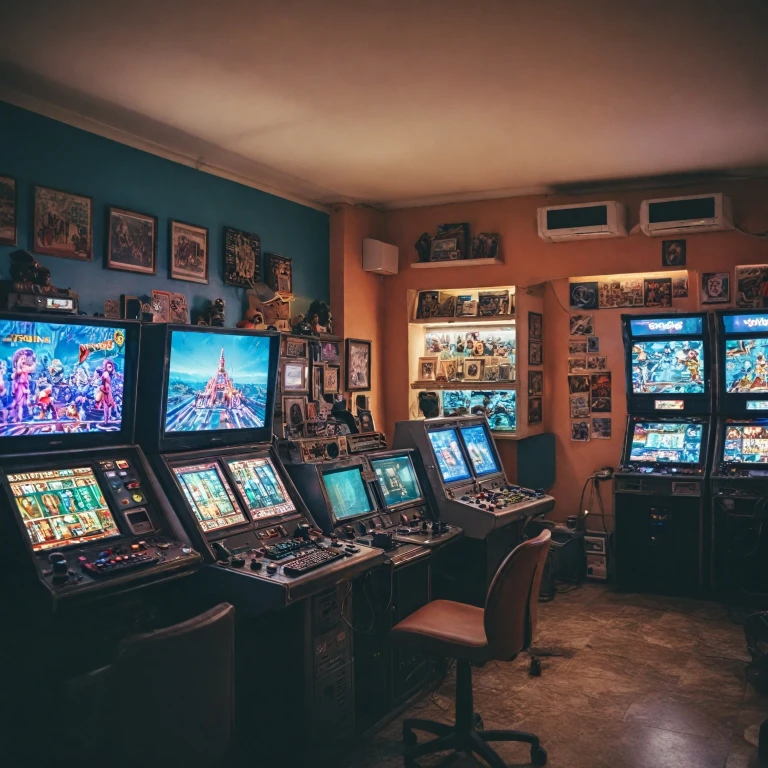The Evolution of the Super PC Engine
The Development of an Iconic Game Console
The journey of the Super PC Engine is a fascinating tale of innovation and adaptation. Born out of a collaboration between NEC and Hudson Soft, the consortium sought to create a gaming console that would push the boundaries of existing video game technology. Released in Japan, the console quickly gained traction under the name PC Engine, boasting impressive hardware specifications for its time.
The Super PC Engine represented a bold step forward from the original NEC PCE, merging advanced graphics capabilities with a diverse library of video games. The engine itself was an evolution in processing power, contributing to the rapid development of the industry during the late 1980s and early 1990s. In a competitive market dominated by major players, the system pro®ved its worth by offering unique features that appealed to gamers and developers alike.
In a strategic move, the engine sold both as a standalone console and as part of the SuperGrafx lineup. The SuperGrafx console was an enhanced version, poised to compete more directly with other major game consoles of the era. Even though it was met with mixed initial success, the NEC engine and super system remained a beloved option among gaming enthusiasts of the time.
Its release came alongside a range of video games that were hailed for their creativity and engagement. The catalog included ROM-centric titles and exploited the hardware to deliver visually appealing experiences. The strategic alliance between NEC and Hudson Soft enabled the introduction of innovative ROM systems like the engine duo and ten koe to enhance gameplay variety.
Ultimately, the Super PC Engine’s legacy is intertwined with the vibrant history of game consoles. While it did not surpass rivals in sales, its impact on the gaming culture persists. For those interested in delving deeper into the array of video games offered during this era, exploring the top TurboGrafx-16 games for enthusiasts can offer insight into its enduring charm.
Through continual refinement and adaptation, the Super PC Engine carved its legacy as a vital chapter in the evolution of console gaming.
Unique Features of the Super PC Engine
The Distinctiveness and Allure of the Super PC Engine
The Super PC Engine stands out in the gaming world, showcasing a host of remarkable features that set it apart from other consoles. Released by NEC, it represents a significant leap in gaming technology with its innovative hardware and capabilities.
One of the unique aspects is its impressive library of games, which includes popular video game titles that were either exclusive or vastly enhanced for the system. The console's performance, backed by the NEC PCE architecture, delivers a smooth and engaging gaming experience. This performance is further optimized by the ROM system that allows for consistent and reliable gameplay.
Moreover, the Supergrafx version of the console brought a notable enhancement in graphical power, setting a new standard for gaming visuals at the time. It was in Japan that this super system truly made its mark, becoming a coveted piece of hardware among avid gamers. However, the engine supergrafx had a limited release and was available in lesser units compared to its competitors, making it a rare gem.
The console's price point played a crucial role in its market reach, appealing to both casual and dedicated gamers. With decisions influenced by strategic market placement, NEC aimed to balance affordability with cutting-edge technology.
Additionally, Hudson Soft's contribution as a third-party developer enriched the catalog with titles that highlighted the system's potential. Notably, the engine duo capable of playing both PCE and CD-ROM games provided a significant versatility advantage in the landscape of video game consoles.
For those interested in understanding its broader context, the Super PC Engine's legacy can be compared with other innovative consoles from its era, such as
the Sega Genesis and Mega Drive, offering insights into the evolution of gaming technologies during that period.
The Impact on Gaming Culture
Redefining the Video Game Landscape
The introduction of the Super PC Engine marked a pivotal moment in the evolution of video game consoles, reshaping the gaming culture across the globe. The console, a product of NEC, brought with it a wave of innovation that forever changed players' experiences. Its impact is noteworthy, influencing subsequent generations and setting new standards in video game technology.
- Enhanced Gaming Experience: The Super PC Engine, often referred to as the engine super, was renowned for enhancing the graphics and offering a superlative gaming experience. With its superior graphics hardware, it allowed developers to push the graphical boundaries, providing players with visual experiences previously thought impossible. Games on this console took on a new life, becoming more immersive and engaging.
- Cultural Icon: Released in Japan, the unit quickly became a cultural icon, earning a revered place in the hearts of gamers. The system's innovative features and exclusive game library positioned it as a must-have for enthusiasts, driving sales and establishing its presence in the gaming world. The NEC Engine was more than just a technological leap; it was a symbol of a new era for video games.
- Influence on Game Design: The console's ROM system and capabilities had a substantial impact on the way games were developed and perceived. Developers began to craft games that utilized the full power of the Super PC Engine, resulting in titles that stood apart due to their exceptional quality and creativity.
In an age where video games were still developing, the Super PC Engine emerged as a leader, not merely in hardware specifications but in how gamers perceived and interacted with their games. To further understand its influence, it's beneficial to compare it with other systems of the time, especially considering its ambitious move into international markets like the United States, where it was known as TurboGrafx. The contributions of Hudson Soft and the introduction of the SuperGrafx console further highlight the strategic vision behind the NEC PCE approach.
The Super PC Engine's legacy continues to inspire current generation consoles, pushing the envelope of what is expected from a
leading-edge console, even years after its initial release. Its pioneering spirit and pursuit of excellence have paved the way for the continuous evolution of gaming technology, making it a cornerstone in video game history.
Hardware Power for Exceptional Performance
The Super PC Engine stands out in the realm of gaming consoles with its impressive hardware and performance capabilities. Designed to satisfy gamers looking for speed and efficiency, the Super PC Engine pushes the boundaries of what we expect from a console.
The heart of the Super PC Engine lies in its advanced engine, developed by NEC. This powerful engine forms the backbone of the system's processing prowess, enabling high-performance gaming experiences that were once unimaginable. While not as popular as other consoles in its day, its technical achievements are noteworthy.
Equipped with superior specifications, the NEC PCE offers robust processing abilities reminiscent of the era-defining systems, such as the Supergrafx and TurboGrafx. It makes use of an enhanced engine supergrafx, which allows for smoother, more dynamic gameplay that can handle complex graphics better than many of its contemporaries.
Comparative Analysis: Standing Strong
When placed alongside its rivals, the Super PC Engine boasts a competitive edge, particularly in terms of its efficient use of ROM and hardware. Its released video games, developed in collaboration with Hudson Soft, showcase the console's capability to offer both visually appealing and engaging gameplay experiences.
While units sold may not have rivaled leading consoles of its time, the Super PC Engine fortified a strong fan base in Japan, where it capitalized on its detailed graphics and diverse game library. Its sale price, though considered an investment, was seen as a fair exchange for its performance level and innovative features.
The NEC engine ensures that every Super ROM and game console produced under this line continues to appeal to enthusiasts of retro and modern gaming. From its initial release to its current standing, this console has proven itself a powerful contender, comparable yet unique in the vast landscape of game consoles.
Comparing the Super PC Engine with Other Consoles
Comparative Analysis of the Super PC Engine's Market Position
When examining the Super PC Engine, especially in the context of its contemporaneous gaming consoles, a few noteworthy aspects stand out. The Super PC Engine by NEC was introduced during an era that was bustling with intense console competition. While its hardware and unique offerings distinguished it, let's delve into how it stacks up against some of its peers such as the Sega Genesis and the Super Nintendo Entertainment System (SNES).
- Hardware and Performance: The Super PC Engine, also known in some markets as the PC Engine SuperGrafx, boasted upgraded hardware compared to its predecessors. However, despite its enhancements, it faced stiff competition from the Sega Genesis with its technological prowess, and the SNES, known for its expansive game library and Mode 7 graphics.
- Library of Games: Supported by NEC and Hudson Soft, the Super PC Engine had a robust collection of games. It included several Super ROMs that were technically advanced for its time. Yet, the shadow of game libraries from consoles like the SNES and the Genesis, which included popular franchises and titles, was hard to escape.
- Market Success and Sales: While the NEC PCE thrived in its initial reception, especially in Japan as units sold were impressive, its global footprint struggled against the sales figures of frontline competitors. Price point considerations and varying levels of marketing efforts in Western countries influenced this dynamic.
- Unique Features: Where the NEC Engine console succeeded was in its innovative features. The console's hardware deck allowed for a unique gaming experience, setting it apart with options for expanded systems like the CD-ROM² and Super System Unit, which offered enhanced gameplay possibilities.
In retrospect, the Super PC Engine represents an ambitious pursuit by NEC to innovate and disrupt the gaming console landscape. Despite facing competitive challenges, its legacy remains pivotal in demonstrating the evolving nature of video game systems in the late 1980s and early 1990s.
Future Prospects for the Super PC Engine
Looking Ahead: The Super PC Engine's Role in the Future
As we consider the future of the Super PC Engine, it's essential to acknowledge the factors that could influence its continued success in the gaming console market. Given its storied past and the impressive capabilities detailed earlier, this system stands poised to evolve in exciting new ways.
One of the main aspects that could shape the Super PC Engine's future is its ability to embrace technological advancements. As we've seen, the console's unique hardware and the collaborative efforts with Hudson Soft have already set a strong foundation. However, to maintain its relevance, the Super PC Engine might need to integrate more modern features, potentially enhancing compatibility with contemporary video game technologies and possibly expanding its library with classic and new titles.
The market is ever-changing, with fluctuating consumer preferences and technological innovations, so the Super PC Engine—and by extension, the engine's technical prowess and the fascinating PCE units—must continue to captivate gamers. Price considerations will likely remain pivotal; offering competitive pricing while ensuring the console doesn't compromise on performance could help attract newer audiences in addition to nostalgic fans.
Moreover, since the console industry remains highly competitive, the Super PC Engine would benefit from a strategic marketing approach, especially reflective of its Japanese market roots, where it initially thrived. With a stable presence in its home market, expansion strategies could involve targeting international markets where retro gaming has a dedicated fan base.
Lastly, collaborating with video game developers to release new games, perhaps even exploring partnerships with indie game creators, could infuse fresh energy into the system. By continually refining its software capabilities and leveraging its existing fan community, the Super PC Engine has the potential to remain a beloved part of the gaming community for years to come—keeping pace with advancements and nostalgia alike.

